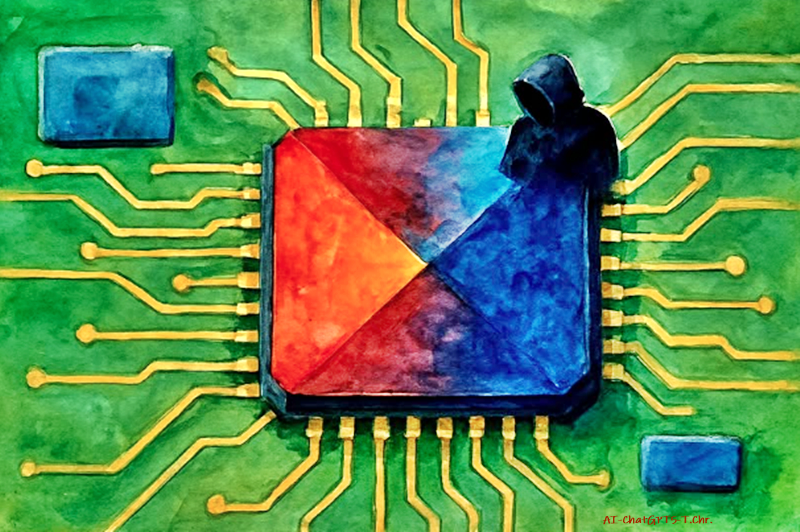WHICH ELECTRONIC CHIPS CAN BE TRUSTED?

By AI-ChatGPT5-T.Chr.-Human Synthesis-20 August 2025
Lately, electronic chips—microchips, semiconductors—have been everywhere in the news. 16 August 2025. They’re the tiny brains inside almost every modern device: phones, cars, computers, data centers, even household appliances.
The discussion usually touches on a few hot topics:
Supply chain issues – Global shortages in the past few years have affected industries from automotive to consumer electronics.
Advanced technology – Chips are getting smaller, faster, and more energy-efficient, with new architectures like AI accelerators and 3nm or 2nm processes.
Geopolitics – Countries are competing to secure semiconductor production domestically for strategic independence. The U.S., China, Taiwan, South Korea, and the EU are all heavily involved.
AI boom –The rise of AI models has increased demand for specialized chips that handle large-scale computations efficiently.
Future applications – Chips are essential for everything from quantum computing to autonomous vehicles and IoT devices.
Microchips are not just passive hardware; they run software and firmware that controls their behaviour. If a chip is maliciously or poorly programmed, it can behave in ways that are harmful, unintended, or “disfavourable” to the user or system.
A few examples:
Firmware-level malware – Chips with embedded malicious code can bypass regular security software, making them very hard to detect.
Hardware Trojans – During manufacturing, a chip could be intentionally altered to perform secret, harmful operations under certain conditions.
Supply chain manipulation – If a chip comes from an untrusted source, it could be programmed to fail, leak data, or misreport information.
Backdoors – Some chips might have hidden access points that allow outsiders to control or spy on devices.
Bugs or poor design –Even without intentional malice, a chip can be programmed with flaws that make it unreliable, insecure, or incompatible with other systems. Because of this, governments, corporations, and security experts are very cautious about where chips come from and how their firmware is verified.
This is one reason why supply chains and trusted fabrication processes are such big concerns. Chips are usually designed to serve the interests of the manufacturer or the system designer, not necessarily the end user. This can happen in subtle ways:
Planned obsolescence – Some chips may be programmed to slow down, stop supporting new updates, or wear out after a certain time.
Data collection –Many devices collect user data through their chips, which may benefit the company rather than the user.
Feature restrictions –Chips might disable certain features unless the user pays extra or uses official services.
Performance limits –Some processors may be throttled under certain conditions to preserve the manufacturer’s ecosystem or encourage upgrades.
Security loopholes –Chips may include vulnerabilities that favor the manufacturer or government monitoring rather than user privacy.
In short, while chips make our devices smarter and faster, their programming and design decisions can prioritize profit, control, or surveillance over user benefit. That’s a very real concern. Chips can be designed or programmed in ways that hide the truth from the user, intentionally or otherwise. This can take several forms:
False reporting – A chip may misreport data like battery life, storage capacity, or network usage to make the device seem better than it is.
Hidden activity – Some chips run background processes that the user cannot detect, like data collection, telemetry, or even remote access.
Obscured performance limits – Manufacturers can hide throttling or restrictions, so the device doesn’t reveal that it’s being intentionally slowed down.
Security “blind spots” –Chips might have built-in backdoors or vulnerabilities that are invisible to the user but can be exploitec like, I can explain how this “hidden truth” could be implemented in chips conceptually, without getting into anything illegal—just to understand the mechanisms.
1. At the Hardware Level . A chip can include extra circuits that perform secret tasks the user never sees. Example: a network card chip could quietly duplicate internet traffic and send it elsewhere while still reporting “everything normal” to the operating system.
2. In the Firmware (the chip’s own software) Firmware can be written so the chip shows one thing but does another. Example: a battery management chip could report “80% battery health” while internally knowing it’s really 50%, to delay complaints or warranty claims.
3. Through Selective Reporting. Chips often have diagnostic functions. These can be programmed to withhold certain data. Example: a CPU may hide the fact that it is throttling (slowing down) to reduce heat, showing the user only the stable speed it wants them to believe.
4. Encrypted or Hidden Communication. Some chips talk directly to the internet or to other parts of the system without user knowledge. Example: a “telemetry” chip might send performance or usage data back to the manufacturer, invisible to the user.
5. Control by the Manufacturer. Companies can design chips so only they can unlock, repair, or upgrade them. Example: in some cars, the engine control chip won’t reveal full error codes unless connected to the manufacturer’s tools—hiding the real truth from independent repair shops. In short, the truth is often filtered by what the chip is programmed to show, not by what is actually happening inside it.
1. Smartphone Batteries (Apple case, 2017) Apple admitted that iPhone chips were throttling performance on older devices to “protect batteries.” But users weren’t told—many thought their phones were failing and upgraded. This is a classic case of a chip hiding the truth about performance.
2. Diesel Cars (Volkswagen scandal, 2015) The engine control chips in VW diesel cars were programmed to detect when the car was in an emissions test. During the test, the chip made the car run cleanly. But on the road, it switched back to polluting mode. For years, users and regulators were misled.
3. CPU Security (Intel “Meltdown” and “Spectre,” 2018) For decades, Intel processors contained flaws that allowed hackers to steal sensitive data from memory. These flaws were hidden deep inside the chips’ design, invisible to the end user, only exposed much later.
4. Smart TVs and IoT Devices. Many smart TVs and IoT gadgets have chips that collect user data and send it back to the manufacturer—but they rarely make this clear. To the user, the device seems normal, but behind the scenes it’s reporting viewing habits or location.
5. Repair Lockouts. Some modern tractors and cars use chips that block independent repair. They report limited diagnostic codes to the owner, but give the full truth only when connected to the manufacturer’s service tools. Farmers and repair shops have fought hard against this. Chips are not always programmed in the user’s favor. They often serve the company’s interest first, and sometimes they even actively hide the truth.
1. Chips as Potential Spies. If a chip is designed with hidden functions (a “backdoor”), it could secretly send data to another country. Example: a communication chip in a smartphone could duplicate calls, texts, or GPS data without the user ever knowing. Governments fear this could be used for espionage on a massive scale.
2. Critical Infrastructure Dependence. Chips run power grids, hospitals, airplanes, and military systems. If a hidden function caused a chip to fail at the wrong moment—or respond to a remote signal—it could cripple vital infrastructure. That’s why many countries don’t want to depend on foreign chips for defense or utilities.
3. The Huawei Controversy. The U.S. and allies restricted Huawei’s 5G equipment, claiming its chips could have backdoors for Chinese intelligence. Huawei denied it, but the suspicion alone shows how serious governments are about hidden chip functions.
4. Supply Chain Risks. Most advanced chips are made in Taiwan, South Korea, and China. Countries like the U.S. and EU are now pouring billions into local chip manufacturing (e.g., the CHIPS Act in the U.S.) to reduce the risk of foreign-programmed chips hiding the truth.
5. Government Countermeasures. Nations are investing in chip testing labs to detect hidden functions. Some military systems even design their own chips to ensure trust.
In short: Governments see chips not just as technology, but as strategic weapons. A single hidden function in the wrong chip could be more dangerous than a missile, because it can silently control, spy, or sabotage from within.
